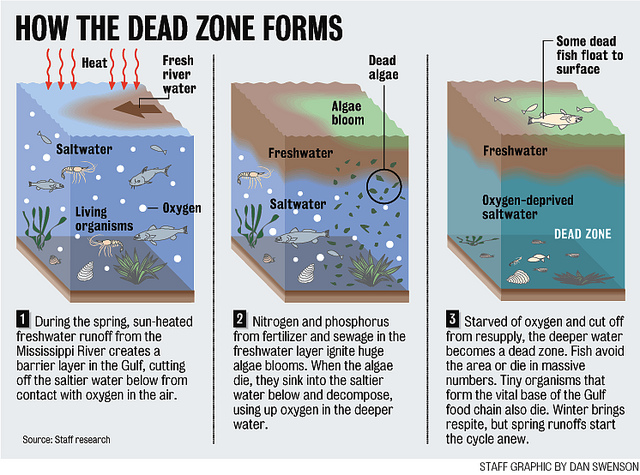Cornucopia’s Take: Because of the timing and amount of water flowing through the Mississippi and Atchafalaya rivers, the large amount of nutrients carried to the Gulf of Mexico from farming and wastewater are causing algal bloom. When the algal bloom dies back, it will use oxygen to break down and leave fish and shrimp in a low oxygen environment. Farmers can mitigate farm runoff by building healthy soil, which requires less fertilizer, and by applying synthetic fertilizer carefully when needed. Synthetic fertilizer is prohibited from use in organics.
NOAA, USGS and partners predict third largest Gulf of Mexico summer ‘dead zone’ ever
National Oceanic and Atmospheric Association
Larger-than-average low and no oxygen area may affect the region’s shrimp fisheries
Federal scientists forecast that this summer’s Gulf of Mexico dead zone – an area of low to no oxygen that can kill fish and other marine life – will be approximately 8,185 square miles, or about the size of New Jersey.
 |
This would be the third largest dead zone recorded since monitoring began 32 years ago – the average Gulf dead zone since then has been 5,309 square miles.
The Gulf’s hypoxic or low-oxygen zones are caused by excess nutrient pollution, primarily from human activities such as agriculture and wastewater treatment. The excess nutrients stimulate an overgrowth of algae, which then sinks and decomposes in the water. The resulting low oxygen levels are insufficient to support most marine life and habitats in near-bottom waters, threatening the Gulf’s fisheries.
The Gulf dead zone may also slow shrimp growth, leading to fewer large shrimp, according to a NOAA-funded study led by Duke University. This could mean higher costs of large shrimp at the marketplace and an economic ripple effect on the Gulf shrimp fisheries.
“The Gulf’s summer hypoxic zone continues to put important habitats and valuable fisheries under intense stress,” said Rob Magnien, director of NOAA’s Center for Sponsored Coastal Ocean Research. “Although there is some progress in reducing nutrients, the effects of the dead zone may further threaten the region’s coastal economies if current levels remain.”
This NOAA-sponsored forecast is based on nutrient runoff and river discharge data from the U.S. Geological Survey. The forecast assumes typical weather conditions, and the actual dead zone could be disrupted by hurricanes and tropical storms.
This year’s predicted large size is due mainly to heavy May stream flows, which were about 34 percent above the long-term average and carried higher-than-average nutrient loads. The USGS estimates that 165,000 metric tons of nitrate – about 2,800 train cars of fertilizer – and 22,600 metric tons of phosphorus flowed down the Mississippi and Atchafalaya rivers into the Gulf of Mexico in May.
The USGS operates more than 3,000 real-time stream gauges, 60 real-time nitrate sensors, and tracks trends in nutrient loads and concentrations throughout the Mississippi-Atchafalaya watershed, which drains parts or all of 31 states.
“As algal blooms and hypoxia become more widespread and their effects more pronounced, the USGS’s long-term monitoring and real-time sensors, coupled with watershed modeling, will continue to improve our understanding of their causes and the role they play in the Gulf and in lakes and streams across the country,” said Don Cline, associate director for the USGS Water Mission Area.
The partners plan to confirm the size of the 2017 Gulf dead zone in early August, following monitoring surveys.
The ensemble of models that are the foundation of the forecast was developed by NOAA-sponsored teams of researchers at the University of Michigan, Louisiana State University, Louisiana Universities Marine Consortium, offsite link, Virginia Institute of Marine Sciences/College of William and Mary, Texas A&M University, North Carolina State University and the USGS.
To help reduce nutrient runoff, NOAA provides information to farmers through its Runoff Risk Advisory Forecasts, which tell them when to avoid applying fertilizers to their croplands.

